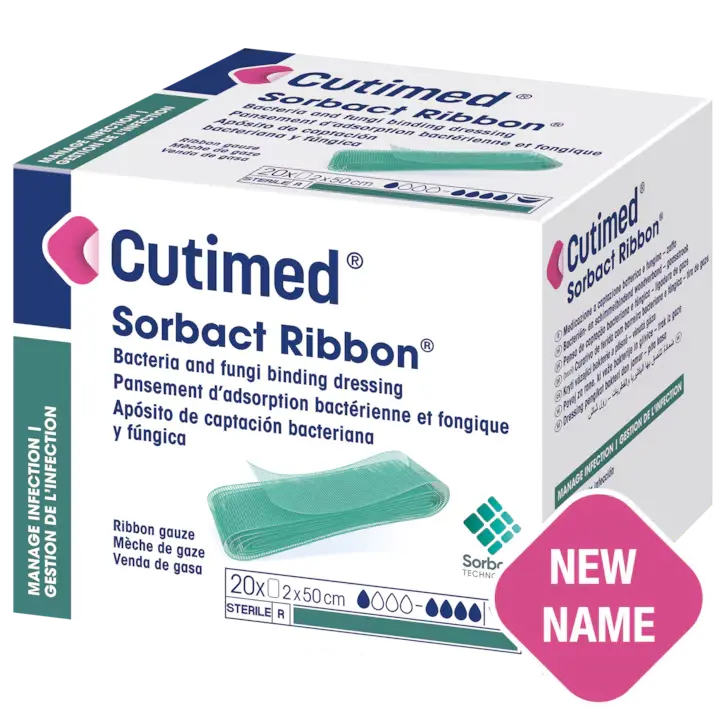Cutimed® Sorbact Ribbon® is a DACC™-coated bacteria and fungi binding ribbon gauze, based on Sorbact® Technology. It is suitable as a wound filler and allows passage of wound exudate into a secondary dressing. Can also be placed in skin folds to treat fungal infections (intertrigo).
- Prevents and treats wound infection
- Safe removal of bacteria, fungi and endotoxins
- Effective against most common resistant pathogens
Intended Purpose
Cutimed Sorbact Ribbon is intended for use in the management of clean, contaminated, colonized or infected exuding wounds, such as surgical wounds, traumatic wounds, pressure ulcers, diabetic foot ulcers and leg ulcers. It can be used on superficial and deep wounds such as cavity wounds and fistulas. Cutimed Sorbact Ribbon is also intended to treat fungal infections in skin folds (intertrigo).
Wear time: Should the clinical condition allow, the dressing can be left in place for up to 7 days.
Prevents and treats wound infection
Sorbact Technology dressings reduce bioburden and support effective wound healing, with no known contraindications and low risk of allergies1, 2, 3, 4, 5, 6.
Safe removal of bacteria, fungi and endotoxins
Sorbact Technology dressings irreversibly bind and remove bacteria, without the release of active agents to the wound5. Development of bacterial or fungal resistance is not expected.
Effective against most common resistant pathogens
In vitro tests show that Sorbact Technology dressings are able to inhibit the growth of the Top 5 World Health Organization (WHO) pathogens7.
Can be cut to suitable size and shape
Easy to cut to any size and custom shape to adapt to your needs, making it suitable for many wound types.
Easy to remove
By leaving the end of the dressing outside the cavity or fistula, it is easy to remove in one piece.
How to use
1. Prepare the wound and surrounding skin according to local clinical practice.
2. Select an appropriate dressing size for the wound. The dressing may overlap the wound margins if needed.
3. Remove the dressing from the peel pouch using an aseptic technique.
4. If needed, cut across the dressing using an aseptic technique. Do not cut over the wound. Discard any unused dressing.
5. Apply the dressing. Ensure that the dressing comes into direct contact with the complete wound surface to allow microorganisms to bind to the dressing. In cavities or fistulas, avoid dense packing. Always leave a part of the dressing outside the cavity/fistula for easy removal. If the dressing is cut, always leave the cut end outside the wound to avoid residual threads.
6. Apply a secondary dressing appropriate for the exudate level such as a foam dressing, absorbent pad or gelling fiber dressing, and fixate.
7. The dressing change frequency depends on exudate levels and the overall condition of the wound and surrounding skin. Should the clinical condition allow, the dressing can be left in place for up to 7 days.
How to Remove
Should the dressing adhere to the wound, moisten the dressing to assist removal and to avoid disruption of wound bed and surrounding tissue.
Features:
Effective against all fungi and bacteria.
No bacterial resistance.
No risk of allergies.
No cytotoxicity.
No contraindications.



